The Physics of Angry Birds
20769
You know the game, I know you know. rovio.com. I have an attraction to games like this. You can play for just a little bit at a time (like that) and each time you shoot, you could get a slightly different result. Oh, you don’t know Angry Birds? Well, the basic idea is that you launch these birds (which are apparently angry) with a sling shot. The goal is to knock over some pigs. Seriously, that is the game.
But what about the physics? Do the birds have a constant vertical acceleration? Do they have constant horizontal velocity? Let’s find out, shall we? Oh, why would I do this? Why can’t I just play the dumb game and move on. That is not how I roll. I will analyze this, and you can’t stop me.
I think for later Angry Bird analysis, I will make my own videos. But for now, I will use some of the walkthrough videos provided by rovio.com. In particular, I am going to use one of these (Spoiler Alert):
How do you get the data from the bird? I will use my favorite cabrillo.edu. The nice thing about Tracker (other than being free and running Windows, Mac, and Linux) is that it has a nice feature to handle both panning and zooming videos – cabrillo.edu. The basic idea is to mark two features in the video and follow these throughout the clip. By marking the location of these two objects in each frame, Tracker will scale, pan and rotate the data as needed.
One more thing. Scale. What is the scale? Who knows? Let me start with an object that should be in each level – the sling shot. I am going to call the length of this 1 AB.
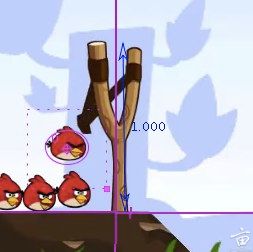
Now on to the data. Here is a plot of the horizontal (x) position of the bird as a function of time:
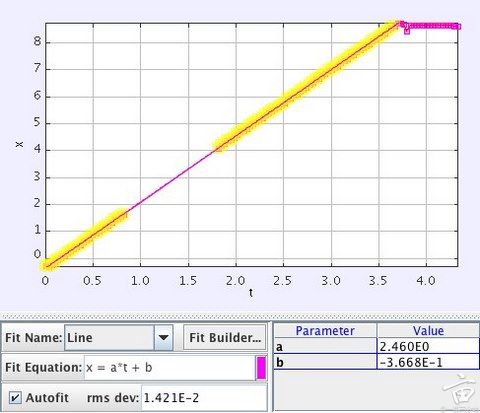
What does this mean? This means that the bird was moving at a constant velocity in the x-direction. In this case, the x-velocity is 2.46 AB/s (assuming the video runs in real time). Is this good? Well, suppose this is real physics and real projectile motion. In that case, this would be a force diagram for the bird in the air:
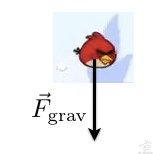
Yes, it is that simple. The only force acting on the bird (if the bird is not moving too fast) would be the gravitational force from the Earth. This is where I see lots of intro-student mistakes. They tend to want to put some force in the horizontal direction because the bird is moving that way. DON’T do that. That is what Aristotle would have you believe, but you don’t want to be in his club. There is no horizontal force in this case – no air resistance.
What about the vertical motion?
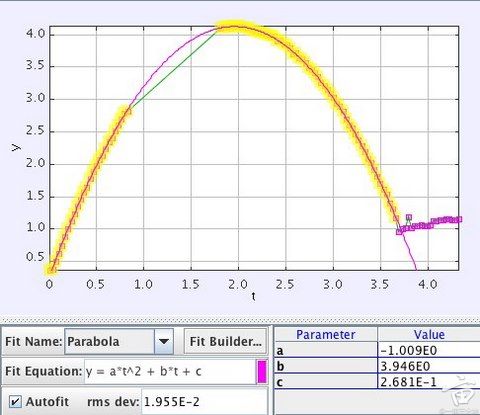
Oh, I forgot to point out that the missing data in the graph is from where the bird went off the screen. This also shows the vertical motion having constant acceleration (because the quadratic equation fits so well). Relating this function to the kinematic equation:

The value in front of the t2 term should be 1/2 times the acceleration. This means that the acceleration of the bird (in the vertical direction) is -2 AB/s2. What if this angry bird is actually on Earth? On Earth, the vertical acceleration should be -9.8 m/s2. I can use this to find the length of that sling shot as:
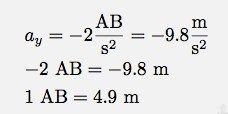
That is one big ole sling shot, 5 meters tall? Wow. Measuring the red bird, it is almost 70 cm tall. That’s a big bird. Big, angry bird.
But what about the physics? Do the birds have a constant vertical acceleration? Do they have constant horizontal velocity? Let’s find out, shall we? Oh, why would I do this? Why can’t I just play the dumb game and move on. That is not how I roll. I will analyze this, and you can’t stop me.
I think for later Angry Bird analysis, I will make my own videos. But for now, I will use some of the walkthrough videos provided by rovio.com. In particular, I am going to use one of these (Spoiler Alert):
How do you get the data from the bird? I will use my favorite cabrillo.edu. The nice thing about Tracker (other than being free and running Windows, Mac, and Linux) is that it has a nice feature to handle both panning and zooming videos – cabrillo.edu. The basic idea is to mark two features in the video and follow these throughout the clip. By marking the location of these two objects in each frame, Tracker will scale, pan and rotate the data as needed.
One more thing. Scale. What is the scale? Who knows? Let me start with an object that should be in each level – the sling shot. I am going to call the length of this 1 AB.

Preview
Now on to the data. Here is a plot of the horizontal (x) position of the bird as a function of time:

Preview
What does this mean? This means that the bird was moving at a constant velocity in the x-direction. In this case, the x-velocity is 2.46 AB/s (assuming the video runs in real time). Is this good? Well, suppose this is real physics and real projectile motion. In that case, this would be a force diagram for the bird in the air:

Preview
Yes, it is that simple. The only force acting on the bird (if the bird is not moving too fast) would be the gravitational force from the Earth. This is where I see lots of intro-student mistakes. They tend to want to put some force in the horizontal direction because the bird is moving that way. DON’T do that. That is what Aristotle would have you believe, but you don’t want to be in his club. There is no horizontal force in this case – no air resistance.
What about the vertical motion?

Preview
Oh, I forgot to point out that the missing data in the graph is from where the bird went off the screen. This also shows the vertical motion having constant acceleration (because the quadratic equation fits so well). Relating this function to the kinematic equation:

Preview
The value in front of the t2 term should be 1/2 times the acceleration. This means that the acceleration of the bird (in the vertical direction) is -2 AB/s2. What if this angry bird is actually on Earth? On Earth, the vertical acceleration should be -9.8 m/s2. I can use this to find the length of that sling shot as:

Preview
That is one big ole sling shot, 5 meters tall? Wow. Measuring the red bird, it is almost 70 cm tall. That’s a big bird. Big, angry bird.
9条回复